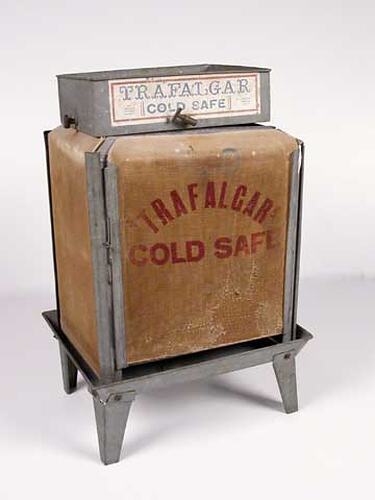Summary
Alternative name Cold Safe, Meat Safe.
W.J. Rawling, Trafalgar, wood, metal and hessian Coolgardie safe.
Made by W.J. Rawling in South Australia, circa 1915.
Invention of the Coolgardie Safe is credited to Arthur Patrick McCormick. In the last decade of the 19th century, Coolgardie was the capital of the West Australian goldfields. Being 180 kilometres from the nearest civilisation, food supplies were initially scarce and expensive. As fresh food was a valuable commodity, there was incentive to preserve it and keep it out of reach of scavengers. It was in an effort to do this that McCormick came up with his design for the Coolgardie Safe. McCormick noticed that a wet bag placed over a bottle cooled its contents. He further noted that if this bottle was placed in a draught, the bag would dry out more quickly, but the bottle would get colder. What McCormick had discovered was the principle of evaporation: 'to change any liquid into a gaseous state requires energy. This energy is taken in the form of heat from its surroundings.' (Ingpen 1982: 18) Employing this principle, McCormick made a box for his provisions which he covered with a wet Hessian bag. He then placed a tray on top, into which he poured water twice daily. He hung strips of flannel from the tray so that water would drip down onto the Hessian bag, keeping it damp. McCormick's safe was handmade using materials to hand. Many other prospectors in the Coolgardie region copied the design. In the early 20th century, Coolgardie Safes were manufactured commercially across Australia, and found there way into homes in both rural and urban areas. These safes incorporated shelving and a door, had metal or wooden frames and Hessian bodies. The feet of the safe were usually placed in a tray of water to keep ants away.
Physical Description
A rectangular, metal and hessian, meat safe with three component parts: a deep rectangular metal tray sitting atop a sloping shouldered, metal frame with hessian panels, resting in a shallow metal dish with 4 legs. TOP: rectangular water tray with 4 drip traps centred on each side. Paper labels are applied to the underside and front panel of the tray. Left side, moulded product information. BODY: metal frame supporting hessian panels. DOOR - a vertical, pin latch at left and hinges as right. Product information in red paint across top. INTERIOR: removable metal shelf. BASE: tapering legs at corners of dish.
More Information
-
Collecting Areas
-
Acquisition Information
Purchase
-
Maker
William John Rawling, Pulteney Street, Adelaide, Greater Adelaide, South Australia, Australia, circa 1915
Patent 15,436/15 applied for 08 Feb 1915. -
Inscriptions
TOP: paper label on front of tray printed "TRAFALGAR/ BY ROYAL LETTERS PATENT/ COLD SAFE/ NOs. 3410-17 15436-15 9624-15". Moulded on side "TRAFALGAR/ SIZE 0/ COLD SAFE/ PATENTED/ NOs 34010-11 15436-15/ 9624-18/ NO/ W.J.RAWLING. S. AUS." Underside label "Directions for Assembling/ THE/ "Trafalgar" Cold Safe/ AND USING SAME./ PATENT Nos. 3410/11 15435/ 15 9624/18" and "DIRECTIONS FOR USE". FRONT: printed "TRAFALGAR/ COLD SAFE".
-
Classification
Domestic life, Food & drink preservation, Cabinets - evaporative cooling
-
Category
-
Discipline
-
Type of item
-
Overall Dimensions
43 cm (Length), 34 cm (Width), 73 cm (Height)
-
Exhibition Collection Management
43 mm (Length), 34 mm (Width), 73 mm (Height)
-
References
Directions for Use Label applied to the underside of the water tray.
-
Keywords
Australian, Household Appliances, Refrigeration, Meat Safes, Innovation & Design


